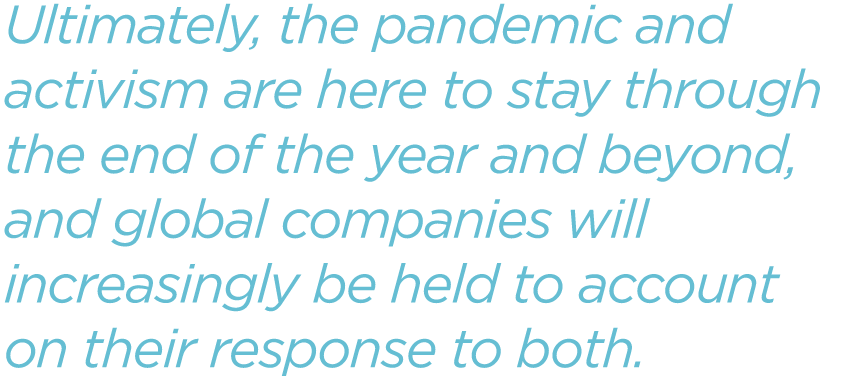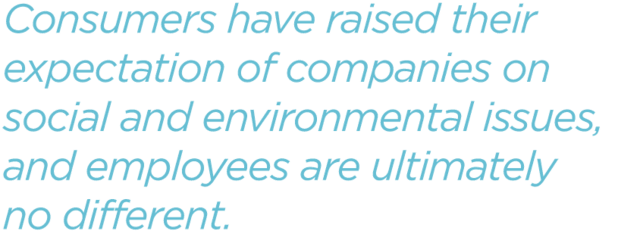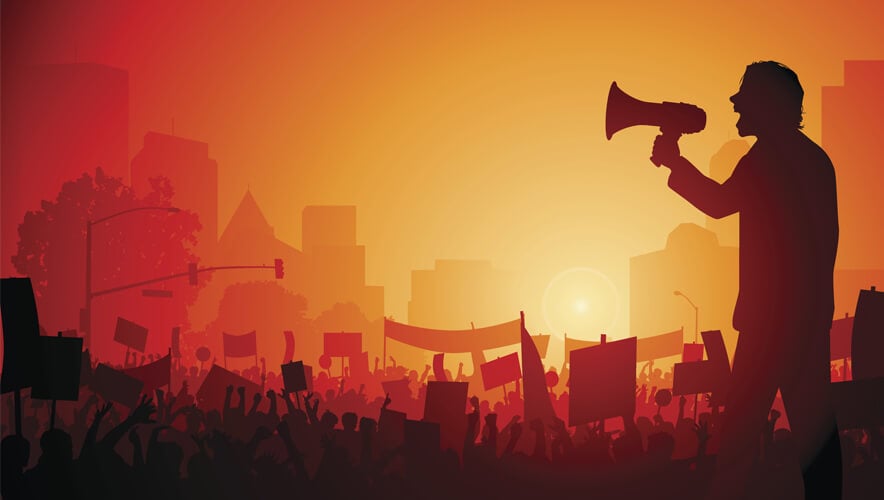Change Drivers: Organizations Face Supercharged Activism
Activism and widespread demonstrations have strongly affected cities and countries worldwide over the past year, driven by concerns around climate change, inequality, democracy, and social justice. Hundreds of thousands of protesters marched in Hong Kong for months in 2019. In the United States, half a million people turned out on one day—6 June 2020—to participate in Black Lives Matter protests.
In addition, the COVID-19 pandemic is highlighting emerging challenges around healthcare inequality, job loss, and a widespread economic recession. These social issues are expected to affect businesses as well.
According to a special edition of Control Risks’ RiskMap, released in July 2020, one of the top five risks facing global organizations this year is that the drivers of activism are being supercharged, leading to reputational and security risks at greater speeds than ever before. Activists are citing the COVID-19 pandemic as the impetus for radical social and economic policy change, and global companies will likely come under increased scrutiny and pressure to address historically taboo issues such as racism and inequality.
Writing for Control Risks, Charles Hecker and Caspar Leighton noted: “Both companies and governments should expect to be grilled for their pandemic management tactics. Governments will be held to account for their death rates and infection counts. But the public will also want to know what companies did during the crisis. Which companies laid off workers, and how many? Which companies had inferior healthcare coverage? Which companies were good to their customers, suppliers, and surrounding communities?”
“Systemic racial discrimination in the U.S.—which draws as well from income inequality and is accelerated by the pandemic’s disproportionate blow to racial and ethnic minorities—promises to make the coming year pitched with protest,” Hecker and Leighton continued. “As large protests worldwide in solidarity show, addressing racial, ethnic, LGBTQI, sectarian, and other forms of discrimination is not just a U.S.—or indeed a purely governmental—problem. Global companies will come under increasing pressure to ensure their diversity, inclusion, and ethics policies meet the moment.”
To dig deeper into this issue and what it means for organizations’ security leaders, Security Management connected via email with Allison Wood, an associate director at Control Risks, who oversees its political risk consulting practice in the U.S. and Canada.
How has activism and social unrest affected organizations this year?
AW. Although there has been renewed attention toward activism in the U.S. in recent months, a global increase in activism predates the pandemic. Tracking, anticipating, and mitigating social unrest activity was already rising in the agendas of many of our clients from mid-2019 onward, with many organizations seeking to better anticipate protests to avoid operational disruption. The onset of the pandemic shifted the attention of many organizations, and lockdowns put a lid on many mass protest movements. But as restrictions have been lifted, so too has the lid on social activism—and increasingly we’ve seen people across the globe defy mandated curfews and social distancing measures to take to the streets.
Ultimately, the pandemic and activism are here to stay through the end of the year and beyond, and global companies will increasingly be held to account on their response to both. Organizations are dealing with the strategic challenge of developing agile approaches to managing these risks, and the more practical challenge of battling fatigue within security, intelligence, and crisis management teams.

Are there specific regions or types of business that have been targeted in activism or social unrest movement recently?
AW. One of the things that was remarkable about the wave of unrest that we saw in May and June in the U.S. was just how pervasive protests were. While metropolitan areas saw the largest protests, there was activity in suburbs and small towns across the country. While looting activity was mostly in downtown, central business districts, we also saw incidents in suburban locations. Businesses across sectors and locations were held to account for their policies on diversity and inclusion.
This is just one example of an increasingly pervasive global activist society. Protest movements are resuming across all regions—a function of both a relaxation of lockdown restrictions and mounting frustration among populations around government response to the pandemic. While the specific drivers of protest in Ethiopia may be different from those in Thailand or France, there are some clear threads around frustration with government that in most cases have only been exacerbated by the pandemic.
Climate change and inequality were some of the key drivers of activism prior to the pandemic, and these will continue to be key themes. Extractive companies have long been a target of activists, but increasingly we are seeing groups more aggressively target the financial sector or companies that are viewed as directly supporting extractives.
The push for companies to show what they are doing for the greater good will only intensify through the lens of the pandemic; the public will want to know whether companies put people or profits first during this global crisis. We expect human and labor rights to emerge as significant issues over the coming months, as the pandemic has for many organizations exposed weakness in policies that address these issues, particularly in supply chains.
Regarding newly exposed weaknesses around human and labor rights issues, specifically along supply chains, can you share a few examples? What can organizations do to be proactive in their response?
AW. The pandemic has exposed both logistical and integrity weaknesses in supply chains. Many of the issues that have been brought to light in recent months are not new but have been exacerbated as a result of the pandemic.
Recent revelations around the treatment of workers in factories that make clothing for UK-based online retailer Boohoo had been raised by prior investigations into fast fashion supply chains, but were brought to light because of allegations that garment factories—pressured to continue operating despite lockdown measures—were linked to an outbreak of [COVID-19] cases in Leicester. Similarly, a lot of outbreaks in the Gulf and parts of Asia have popped up in housing for migrant workers, many of whom work in construction or service jobs that may have persisted despite other shutdown measures.
Broadly, there are concerns that employers might take advantage of distracted governments and regulators to take health and safety shortcuts.
Companies should map their supply chains so they are aware of which parts will be at a higher risk for these human and labor rights violations, among other issues. This requires taking into account a host of factors, including but not limited to the country, sector, employee population, and dependencies.
Companies that had already done this and had already demonstrated to their suppliers certain standards around social and governance issues have generally had a better sense of how the pandemic would be likely to impact their supply chains on these issues, or at least have had enough information to understand how certain scenarios would be like to manifest. Having this knowledge to hand can help companies to mitigate these risks by getting ahead of issues, instead of reacting to them as they manifest.
How does activism over COVID-19 responses stack up against more familiar drivers like income inequality, climate change, and systemic racial discrimination?
AW. I think it’s becoming increasingly difficult to separate out activism that is driven by COVID-19, versus that driven by other factors. Anti-lockdown protests are perhaps most directly tied to the pandemic, but in most cases existing frustration with socioeconomic disparities underlies these sentiments. Activists are already positioning the pandemic as an impetus for a transformation of environmental, social, and economic policies.
As the second-order economic and social impacts of the pandemic continue to manifest and public frustration mounts, we expect to see these movements gain momentum. These sentiments likely would have existed to some degree absent the emergence of COVID-19, but this common crisis has for many given a renewed sense of urgency around many issues.
How is consumer scrutiny over COVID-19 response likely to affect organizations’ reputations?
AW. Businesses will face renewed scrutiny across the spectrum of stakeholders: shareholders, employees, consumers, and local community members. For many, it’s also no longer a matter of a single issue; instead consumers will have heightened expectations around a company’s positions on the environment, diversity and inclusion, and human rights, among others. Companies will be held to account both through social media and spending patterns, and many consumers will be unforgiving in their response to missteps.

If an organization does misstep in its response to a social movement, protest, or crisis, what can it do to recover stakeholders’ trust?
AW. Activist organizations are increasingly looking for accountability on issues like inequality and climate change, and in some cases government and professional organizations are also instituting measures that encourage or require increased transparency or commitments. When organizations misstep, stakeholders are looking for this transparency and commitments to action. How exactly companies should go about this will depend on the stakeholder they are trying to repair a relationship with—so mapping these stakeholders and understanding their interests an potential influence on your operations is critical in being able to manage these types of incidents successfully. This is something that organizations can and should do proactively, so that this knowledge can be leveraged in a crisis.
How can security leaders participate in guarding the organization’s reputation?
AW. COVID-19 has illustrated the importance of security leaders’ working with colleagues across the business to protect an organization’s reputation. Organizations that have been most successful in managing interruptions to the business brought about by COVID-19 have generally had security and health, safety, and environment (HSE) working closely with colleagues in communications to develop internal and external policies and statements about response.
This opportunity has also given many security leaders an opportunity for them and their teams to demonstrate value to the business beyond their usual tasks—analyst teams have been an essential source of intelligence for many business functions throughout this crisis. Ideally this facilitates a broader cooperation between these functions. For example, security teams tracking trends and activities in activism can share this information with colleagues in communications to facilitate a range of tasks, such as scenario planning, proactive position, and anticipating activist activities.
Are you seeing a rise in employee activism—that is, employees protesting their own organizations or taking action to espouse change at their workplace? How do organizations’ responses to that differ from responses to outside activism?
AW. There have been numerous high-profile examples of increasing employee activism. Consumers have raised their expectation of companies on social and environmental issues, and employees are ultimately no different—they are increasingly seeking to hold their employers to account. Though the drivers of this activism are the same, organizations will typically need to take different postures and tactics in response to internal activism. The forums for discussion, sophistication of dialogue, and expectations of accountability are generally different for internal and external audiences. Security managers are also increasingly asked to distinguish activism from the potential for insider threats.
However, employee activism shouldn’t be seen as a negative phenomenon. Giving employees an opportunity to participate in and lead change within their organization can build camaraderie and commitment among colleagues, leading to greater cooperation and innovation within organizations.
